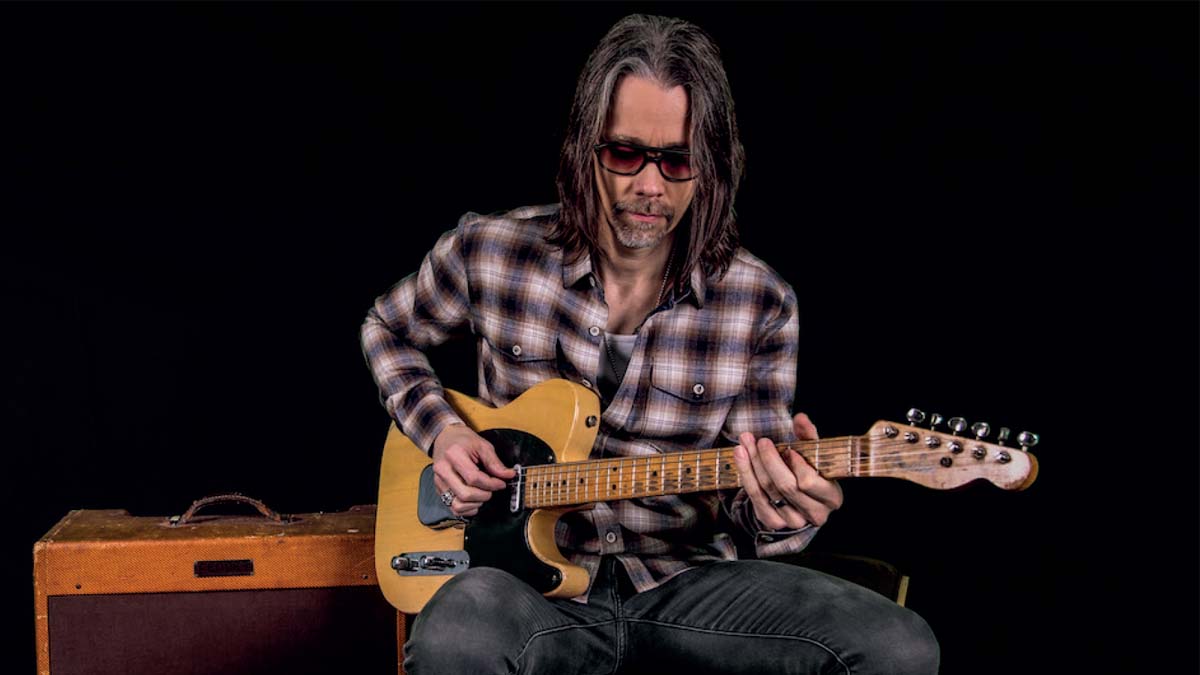Myles Kennedy talks soloing strategies, vintage guitars, and 'fesses up to a sacrilegious mod on a Fender Deluxe
On his latest solo album, The Ides of March, Kennedy brings his blues-rock A-game to the party, and a whole lot of gear

Considering his duties fronting Alter Bridge and Slash’s solo band, Myles Kennedy could very well be one of the busiest musicians in rock. Especially when you factor in his solo work, which began with his 2018 debut, Year of the Tiger, and continues on this year’s The Ides of March.
Unlike his first album, however – or, indeed, any of his projects over the years – the new record showcases a different side of his guitar playing, proving he’s not merely a talented singer and songwriter. Talking to GW from his home studio, Kennedy explains how different situations call for different strengths.
The opening track, Get Along, has some blazing-fast pentatonic runs that are reminiscent of Eric Johnson and Joe Bonamassa.
“Eric Johnson is a big one for me, so I’ve definitely been trying to chase through certain patterns that he kinda invented, and that Joe Bonamassa took to a new level. I figured after all the time I’ve spent working on that stuff, it would be fun to throw in ideas like that here and there.“
There are a couple of moments like on the album where it sounds like groups of five using a mixture of economy and alternate picking.
“There’s definitely some economy going on. Some of that I incorporated from Frank Gambale, who was at the forefront of sweep-picking in the late-'80s. I saw him perform with Chick Corea and remember thinking, 'Wow, what is that?!' Obviously it sounds way different when you incorporate it into more of these pentatonic five patterns and whatnot.
“Mark Tremonti and I were talking about Troy Grady’s instructional videos the other day, specifically the Eric Johnson one where he looks into some of those double strikes, down or up. What’s weird is that I started utilizing that technique but I reversed it… for some reason I find myself going the other way. It’s hard to explain, but I know there are definitely two ups and two downs in places.“
Get The Pick Newsletter
All the latest guitar news, interviews, lessons, reviews, deals and more, direct to your inbox!
Although you’ve played in various bands over the years, it definitely feels like we’ve never heard this side of you before.
“I never really found the right application for a lot of those licks. But this being a more blues-rock record, I felt like sticking to a pentatonic or blues-based approach – especially with the fast runs. It just felt more appropriate.
“In Alter Bridge, we tend to be quite modal at times, with a lot of triplets… it’s just a different approach. I wanted this record to be congruent in terms of the leads. If I was going to have a burn here and there, it would have been inappropriate to kick into some harmonic minor legato run. It just wouldn’t fit!“
You mainly stick with a Diezel Herbert amp in Alter Bridge. How different is the rig in your solo ventures?
“Any time a Diezel was used on this album, it was actually the Schmidt – a discontinued model but a killer amp, like a Vox AC30 on steroids. I used one for my guitar tracks on the second Slash record, Apocalyptic Love. But what I used a lot of this time, because it suited the sound, was a 1958 Fender Deluxe with the 5A3 circuit, which is the magical circuit. It just has this thing.
“I would say it’s the main sound of this album. A lot of the times if we were doubling, we used one of our producer Elvis’s amps [Michael “Elvis” Baskette], this ’74 Marshall combo he had in his collection. And any time I pulled out my ’54 Fender lap steel, we used an Amplified Nation.“
A lot of the record was written on and performed with my ’52 Fender Blackguard Telecaster. In recent years I’ve really become obsessed with Blackguards
What are we hearing in terms of guitars?
“A lot of the record was written on and performed with my ’52 Fender Blackguard Telecaster. In recent years I’ve really become obsessed with Blackguards. This one just has something. I don’t know why – it could be the pickup, which almost sounds like a P-90.
“There’s also a 1958 Gibson ES-335 that has the PAFs in it… basically the same ones you’d find in a Burst, for a fraction of the price. For acoustic stuff, I used the same 1945 Martin I used on [debut-album track] Haunted by Design. It’s a great-sounding instrument. But the one that blew Elvis away was a 1965 J-50, which sounded magical. The great thing about those Gibsons is that they’re not crazy-expensive like some of the old Martins.“

We heard you used a Klon at some point, too.
“Yeah! Though we actually didn’t get an original; we got a clone of a Klon and loved it. We used it a fair amount, especially on the leads and in a way that made its presence known. Another I used was the good old Fulltone Fulldrive 2. For the rhythms, we added a little bit of drive going into the front of the Fender Deluxe, just to push it a little harder. Actually, I committed the ultimate sin right before I went down to make the record…“
Indulge us!
“There’s something you need to do with those 5A3 Fender Deluxes. They don’t like taking pedals in front and a lot of purists say you shouldn’t change them because they sound amazing on their own. So I have to confess – and I might get some crap for this – but I took it to my buddy who tweaked something so it could take pedals a little better.
“And now with the record done, we can return it to its old glory. I knew that amp was going to be such an important part of the sound but needed to make sure that if I was going to do leads, it would let pedals do what they do for us guitar players. That little push makes everything a little easier!“

The solo on Worried Mind shows another side of your playing — minimalist Clapton-esque blues with the odd diminished line.
“Though I wouldn’t consider him to be old-school blues, Larry Carlton was such an important part of my development, especially the way he’d integrate diminished ideas or outside-sounding lines in a blues context.
“Back in the day, I transcribed a fair amount of solos by him and Robben Ford. Those guys, like Clapton, know how to say more with one note than five or 10. When I heard them for the first time, I knew it was something I would have to try and understand... they’re the masters!
“And as far as the diminished side of it, when I discovered what you can do with those half-whole or whole-half tones, boy… it opened up an entirely new world. And I learned it from those guys, but there are a lot of new players who do that brilliantly. One of my favorites is Josh Smith; I have his instructional thing where he explains what he’s doing. If you are on the one chord, diminished ideas seem to work really well as you do that change, using them to lead into the four!“
- The Ides of March is out now via Napalm Records.
Amit has been writing for titles like Total Guitar, MusicRadar and Guitar World for over a decade and counts Richie Kotzen, Guthrie Govan and Jeff Beck among his primary influences as a guitar player. He's worked for magazines like Kerrang!, Metal Hammer, Classic Rock, Prog, Record Collector, Planet Rock, Rhythm and Bass Player, as well as newspapers like Metro and The Independent, interviewing everyone from Ozzy Osbourne and Lemmy to Slash and Jimmy Page, and once even traded solos with a member of Slayer on a track released internationally. As a session guitarist, he's played alongside members of Judas Priest and Uriah Heep in London ensemble Metalworks, as well as handled lead guitars for legends like Glen Matlock (Sex Pistols, The Faces) and Stu Hamm (Steve Vai, Joe Satriani, G3).



![[from left] George Harrison with his Gretsch Country Gentleman, Norman Harris of Norman's Rare Guitars holds a gold-top Les Paul, John Fogerty with his legendary 1969 Rickenbacker](https://cdn.mos.cms.futurecdn.net/TuH3nuhn9etqjdn5sy4ntW.jpg)







